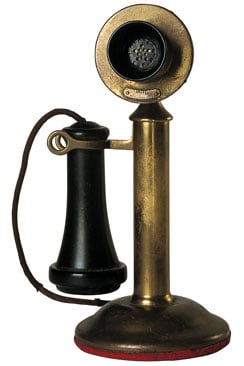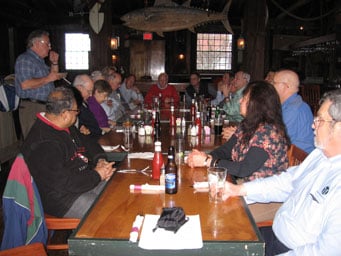This post was authored by Peggie Ward Koon, Ph.D., and originally appeared in ISA's Management Division newsletter.
Did you know that the first spam in computer history was sent on May 3, 1978 by a Digital Equipment Corporation (DEC) employee? Over 400 people received a promotional m essage sent via the company’s ARPANET network. Yes, email and spam and many of the other collaborative technologies used today are dated -- pre-PC. In fact eons ago, (I have to be careful not to reveal my age…), I remember using VMS-Mail to send messages to colleagues in the office down the hall, in another building, or at another site. The text editor was called EVE – and no one spoke of her predecessor.
essage sent via the company’s ARPANET network. Yes, email and spam and many of the other collaborative technologies used today are dated -- pre-PC. In fact eons ago, (I have to be careful not to reveal my age…), I remember using VMS-Mail to send messages to colleagues in the office down the hall, in another building, or at another site. The text editor was called EVE – and no one spoke of her predecessor.
And before Microsoft Office™ there was DEC’s All-In-One. Yes, believe it or not, we had software that included a calendar, a calculator, a word processor, task manager, mail boxes, contacts, etc. Sound familiar? As I recall, not everyone had DEC CRT’s on their desktops, so communications with the folks who were using BIG BLUE was by phone, snail mail, or face-to-face. But for those of us who were on the corporate DEC network, communications between each other and across the company’s WAN (from plant to plant) was a breeze!
Back then, being able to use electronic mail was limited. It was definitely not one of the main methods of inter-office communications. In fact, in manufacturing it was often only used when engaged with someone interactively either in plant floor communications, problem solving, or to expedite delivery of reports or report details to another person (usually a higher-up) in the organization. It was definitely not used to send an email from work to my sister in California or my friends in Kowloon!
My how times have changed! Take a quantum leap from then to now! Today, email, SMS, distribution lists, blogs, Twitter, forums, discussion boards – are all integral parts of our every day lives at work and at home. So much so, that many people in the same office never speak to each other to collaborate on a problem, exchange ideas, or even just to say “Hello.” Whatever happened to the old “get up from your desk and walk to the cubicle right in front of you or the office next door to get a question answered” mentality? It’s gone baby gone!
The Changing Nature of Communications
So what does all this interconnectivity mean for communications at work? First, we must recognize that the Internet has changed the concept of inter-personal and inter-office communications. By that I mean, people in the office use this new e-set of communications tools to interact more often – anytime, anywhere, any place. And while we claim we are more interactive, for some folks these tools make the workplace much less personal.
People can communicate,  collaborate, participate in meetings, exchange ideas, etc. without ever seeing each other. Really, I work with folks who have been seated in side-by-side cubicles but have rarely engaged in a good old-fashioned conversation with each other. To add to this dilemma, we are now challenged with managing communications. I read an article in the New York Times about five time management tricks.
collaborate, participate in meetings, exchange ideas, etc. without ever seeing each other. Really, I work with folks who have been seated in side-by-side cubicles but have rarely engaged in a good old-fashioned conversation with each other. To add to this dilemma, we are now challenged with managing communications. I read an article in the New York Times about five time management tricks.
Can you name the #1 trick? You guessed it! Taming the e-mail beast! Remember what I said earlier about spam? Well, with all this interconnectivity, spam is alive and well! Seriously, do you know who sits next to you? Do you feel comfortable asking the person for a lift home when your car breaks down? And what happens when e-mail communications break down? How much time do you spend trying to make sure that an email you sent in haste is not accidentally misunderstood?
Or responding to a thread that includes 10 people with misinformation that was propagated from one email? Not to mention, the back-and-forth that can occur when the tone of an email is misunderstood… (What the heck is tone of an email anyway?) This same anomaly can happen in blogs, forums, etc. I guess that’s why “tweets” are so popular – they’re short and to the point – and there’s no need for a tweet management system – at least not yet. Please don’t mistake my concern for the evolving, fast-paced, fully web-enabled but impersonal office atmosphere that we call “the workplace” as a lack of endorsement for email, Twitter, blogs, forums, or the like.
Not so! I am glad that the Internet and all its multi-faceted mechanisms of communications have arrived and are a part of the fabric of this new generation of e-workers. I would not ever want to return to the era where interaction with my co-workers, professional colleagues, friends, and family is limited by space, distance, or time. But, I also like the idea of taking the time to sit with a colleague face-to-face to discuss an issue or a plan – to look him or her in the eyes to see true feelings -- to feel their energy when they are passionate about a project. And I enjoy not having to be an interpreter – at least some of the time. Over the years, I’ve found technology-driven collaboration to be both fascinating and frustrating – especially when conflict occurs.
Take a Day Off from eCommunications
 Here’s a thought: What would happen if you made a conscious effort to take a day off from electronic communications? Take a moratorium from e-communications one day a week (okay, maybe half a day)! When you need to talk to someone, try picking up the phone or better yet walking over to their cubicle or office.
Here’s a thought: What would happen if you made a conscious effort to take a day off from electronic communications? Take a moratorium from e-communications one day a week (okay, maybe half a day)! When you need to talk to someone, try picking up the phone or better yet walking over to their cubicle or office.
See if your productivity improves. My bet is that not only will you actually see an improvement in personal productivity, but you’ll also improve personal relationships. Isn’t that what we’re after with all this communications technology and social interaction anyway – building relationships? So what are you waiting for? Don’t just sit there. Go chat with somebody – face to face!
About the Author
Peggie Koon, Ph.D., served as president of ISA in 2014 and chair of the Automation Federation. She was vice president of audience at Chronicle Media and The Augusta Chronicle, which are part of Morris Publishing Group, LLC, a privately held media company based in Augusta, Ga. Prior to joining Morris, Peggie developed IT systems for process automation and process control in a variety of industries, including automotive, nuclear defense, aerospace, nuclear reprocessing, thermal ceramics and textiles. Peggie assumed her first ISA leadership position in 1996 as membership chair of the Management Division and has held a variety of prominent leadership roles in the Society. She earned a bachelor’s degree in mathematics from Smith College in Northampton, Mass. and completed graduate studies in industrial and systems engineering at the Georgia Institute of Technology. She received a doctorate in management information systems from Kennedy Western University in Cheyenne, Wyo.



